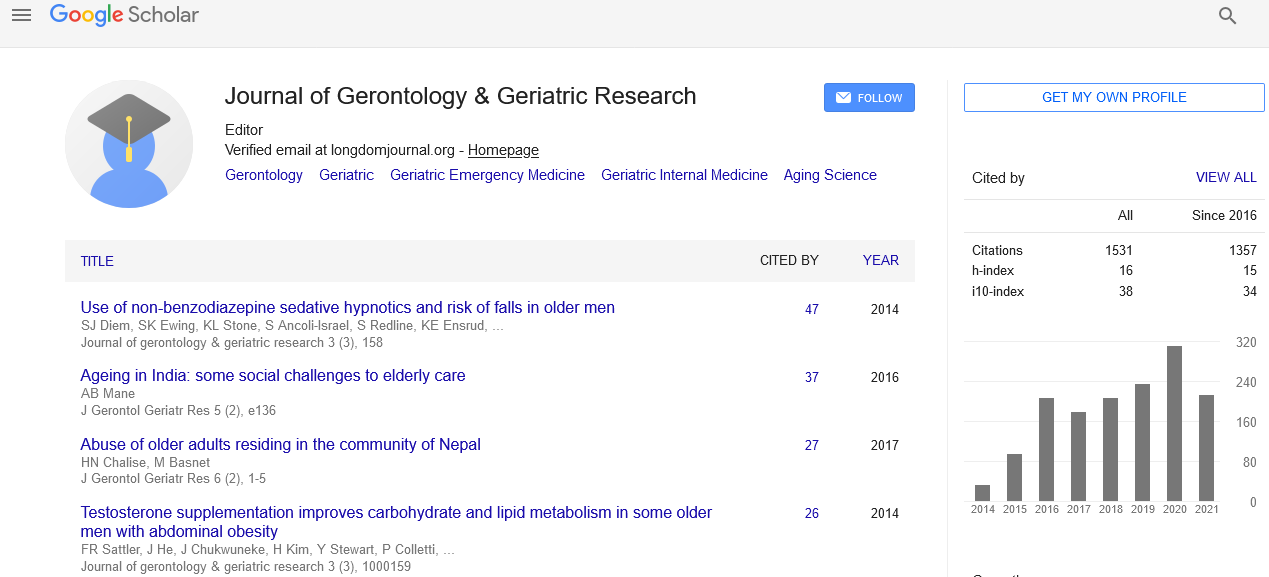PMC/PubMed Indexed Articles
Indexed In
- Open J Gate
- Genamics JournalSeek
- SafetyLit
- RefSeek
- Hamdard University
- EBSCO A-Z
- OCLC- WorldCat
- Publons
- Geneva Foundation for Medical Education and Research
- Euro Pub
- Google Scholar
Useful Links
Share This Page
Journal Flyer

Open Access Journals
- Agri and Aquaculture
- Biochemistry
- Bioinformatics & Systems Biology
- Business & Management
- Chemistry
- Clinical Sciences
- Engineering
- Food & Nutrition
- General Science
- Genetics & Molecular Biology
- Immunology & Microbiology
- Medical Sciences
- Neuroscience & Psychology
- Nursing & Health Care
- Pharmaceutical Sciences
Geriatric Oncology: Caring for the older patient with cancer
International Conference on Geriatrics & Gerontology
July 08-10, 2014 DoubleTree by Hilton Hotel Chicago-North Shore Conference Center, USA
Ranjita Pallavi
Scientific Tracks Abstracts: J Gerontol Geriat Res
Abstract:
Cancer is the leading cause of death in men and women aged 60 to 79 years. More than 50% of all cancers and more than 70% of all cancer-related deaths in the United States occur in patients above 65 years. Age-adjusted incidence rate for all cancers is 2095.8 per 100,000 for patients above 65 years as compared to 223.8 per 100,000 for those under 65. Elderly cancer patients are under-represented in most trials thus limiting the ability of oncologists to extrapolate from trials to practice. Decisions regarding treatment cannot be simply based on chronological age. A more comprehensive approach is required for individualized cancer care. More awareness about geriatric assessment tools is required among oncologists. Management of cancer in the elderly involves unique issues arising from differences in cancer biology due to aging and responsiveness to therapy. Validated standardized tools are available for ?Staging the Aging? to help individualize treatment. These include the Comprehensive Geriatric Assessment (CGA) and Cancer-Specific Geriatric Assessment (CSGA) tools. CGA is a multidisciplinary, detailed evaluation for assessment of life expectancy and the risk of morbidity and mortality in older patients. It also helps in estimating functional reserve and tolerance to chemotherapy. Its use might reduce mortality by 14% . The CSGA is similar and analyzes 7 domains including functional status, comorbidity, poly-pharmacy, cognitive function, psychological status, social functioning and support and nutritional status. Life expectancy calculators are available online and maybe used to calculate anticipated life expectancy irrespective of the cancer diagnosis. Presence of Frailty may affect treatment tolerance and prognosis. Frailty is defined as a clinical syndrome with 3 or more of the following: unintentional weight loss (10 lb or more in the past year), self-reported exhaustion, weakness (grip strength), slow walking speed, and/or low physical activity. It is predictive of adverse outcomes like risk of falls, hospitalization, decreased mobility and death. Co-morbidities in elderly patients may alter cancer behavior. They also impact treatment tolerance and determine if a particular therapy is more risky than another. The following indices may be used to determine the risk of mortality associated with comorbidity: adult comorbidity evaluation-27 (ACE-27) index, Charlson Comorbidity Index (CCI), Cumulative Illness Rating Scale (CIRS) and OARS Multidimensional Functional Assessment Questionnaire. Cancer diagnosis especially in the first 6 months after diagnosis and chemotherapy are associated with increased risk for falls. Older patients undergoing chemotherapy have been found to have an increased risk of drug interactions further complicated by polypharmacy. Polypharmacy has been found to have a higher rate of hospitalization and early discontinuation of chemotherapy. Tools that predict the risk of toxicity like CRASH (Chemotherapy Risk Assessment Scale for High-Age Patients) and CARG geriatric assessment scales should be routinely included in oncologic practice. Future research should focus on formulating the best evidence based care for older patients with cancer. Geriatric oncology should be incorporated into disease-specific clinical practice guidelines.
Biography :
Ranjita Pallavi recently completed her Residency in Internal Medicine from New York Medical College and Metropolitan Hospital Center in Manhattan, New York. She is currently doing her Fellowship in Hematology and Oncology at Westchester Medical Center, New York. Prior to this, she had also completed her MD in Internal Medicine from Grant Medical College and Sir J.J. Group of Hospitals in Mumbai, India.


